RSK80006: Risk Management and Mitigation in Great Rail Australia
VerifiedAdded on 2023/06/14
|11
|2548
|262
Report
AI Summary
This report analyzes the risk management strategies for Great Rail Australia, identifying key risks such as rail safety, regulatory compliance, and occupational health and safety (OHS). It discusses the importance of risk assessment in railway operations and proposes a risk management system including hazard identification using Preliminary Hazard Analysis (PHA), risk evaluation, risk analysis, and risk control. The report emphasizes the need for compliance with the Work Health and Safety Act 2011 and recommends regular training and monitoring to mitigate risks and ensure the safety of passengers and stakeholders.
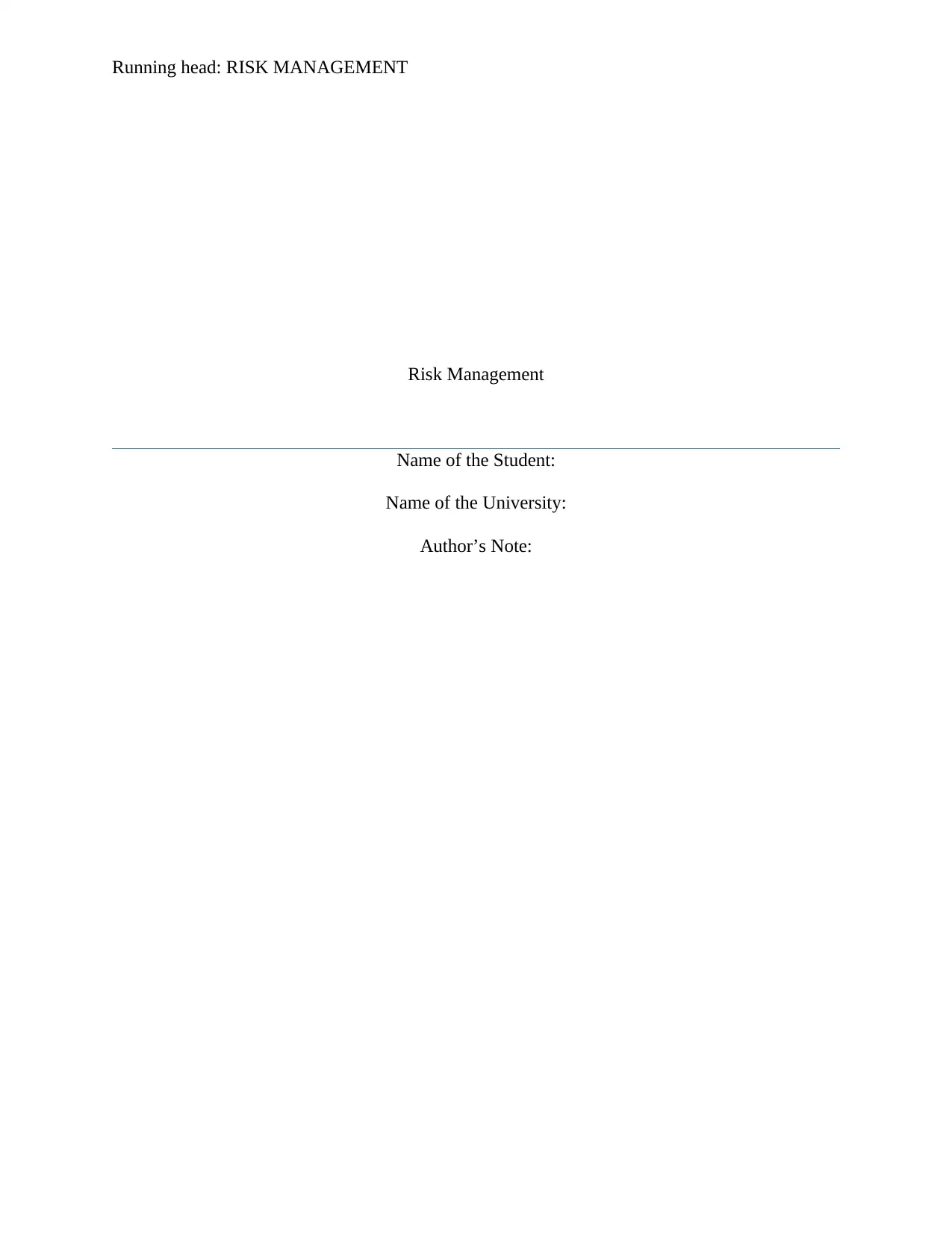
Running head: RISK MANAGEMENT
Risk Management
Name of the Student:
Name of the University:
Author’s Note:
Risk Management
Name of the Student:
Name of the University:
Author’s Note:
Paraphrase This Document
Need a fresh take? Get an instant paraphrase of this document with our AI Paraphraser
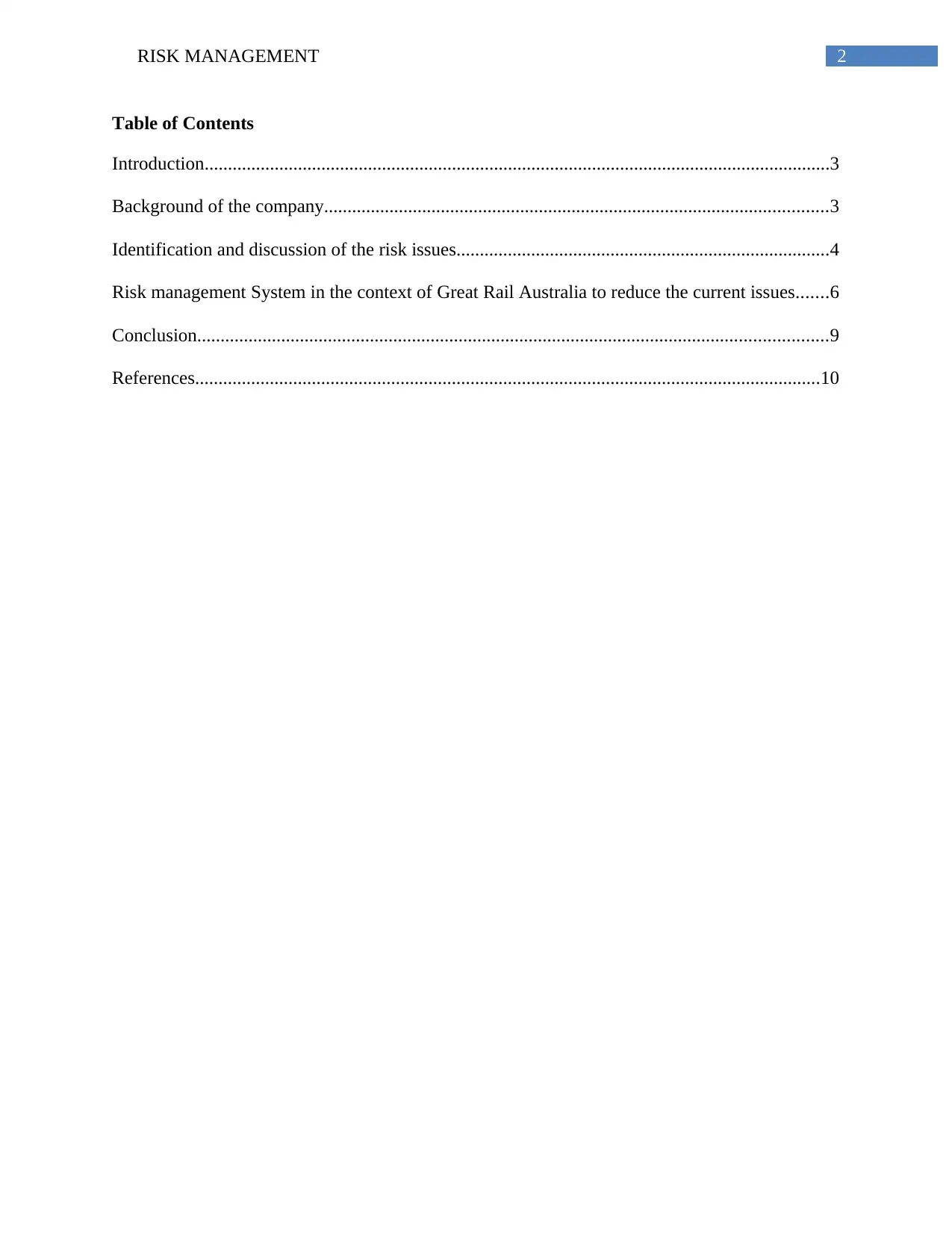
2RISK MANAGEMENT
Table of Contents
Introduction......................................................................................................................................3
Background of the company............................................................................................................3
Identification and discussion of the risk issues................................................................................4
Risk management System in the context of Great Rail Australia to reduce the current issues.......6
Conclusion.......................................................................................................................................9
References......................................................................................................................................10
Table of Contents
Introduction......................................................................................................................................3
Background of the company............................................................................................................3
Identification and discussion of the risk issues................................................................................4
Risk management System in the context of Great Rail Australia to reduce the current issues.......6
Conclusion.......................................................................................................................................9
References......................................................................................................................................10
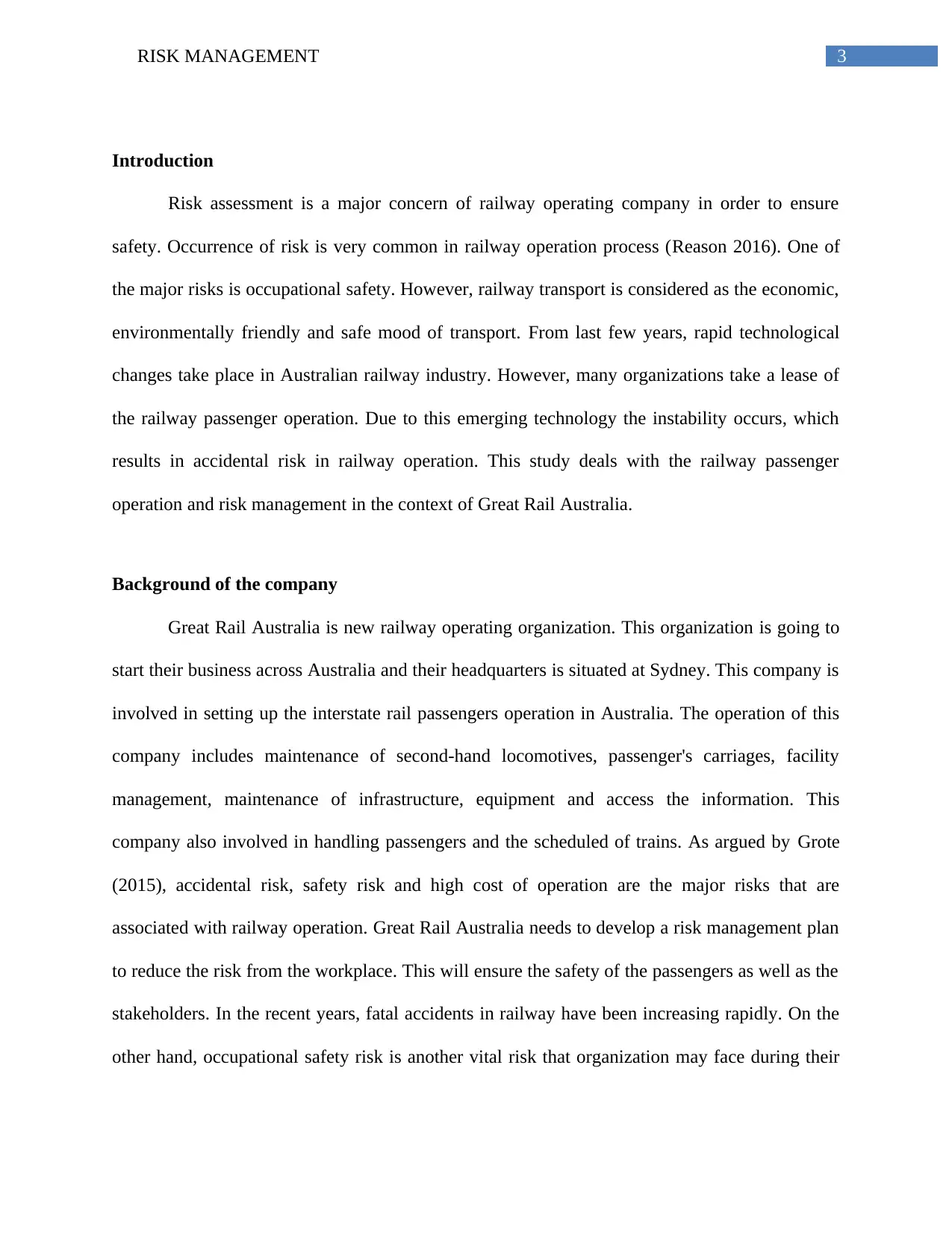
3RISK MANAGEMENT
Introduction
Risk assessment is a major concern of railway operating company in order to ensure
safety. Occurrence of risk is very common in railway operation process (Reason 2016). One of
the major risks is occupational safety. However, railway transport is considered as the economic,
environmentally friendly and safe mood of transport. From last few years, rapid technological
changes take place in Australian railway industry. However, many organizations take a lease of
the railway passenger operation. Due to this emerging technology the instability occurs, which
results in accidental risk in railway operation. This study deals with the railway passenger
operation and risk management in the context of Great Rail Australia.
Background of the company
Great Rail Australia is new railway operating organization. This organization is going to
start their business across Australia and their headquarters is situated at Sydney. This company is
involved in setting up the interstate rail passengers operation in Australia. The operation of this
company includes maintenance of second-hand locomotives, passenger's carriages, facility
management, maintenance of infrastructure, equipment and access the information. This
company also involved in handling passengers and the scheduled of trains. As argued by Grote
(2015), accidental risk, safety risk and high cost of operation are the major risks that are
associated with railway operation. Great Rail Australia needs to develop a risk management plan
to reduce the risk from the workplace. This will ensure the safety of the passengers as well as the
stakeholders. In the recent years, fatal accidents in railway have been increasing rapidly. On the
other hand, occupational safety risk is another vital risk that organization may face during their
Introduction
Risk assessment is a major concern of railway operating company in order to ensure
safety. Occurrence of risk is very common in railway operation process (Reason 2016). One of
the major risks is occupational safety. However, railway transport is considered as the economic,
environmentally friendly and safe mood of transport. From last few years, rapid technological
changes take place in Australian railway industry. However, many organizations take a lease of
the railway passenger operation. Due to this emerging technology the instability occurs, which
results in accidental risk in railway operation. This study deals with the railway passenger
operation and risk management in the context of Great Rail Australia.
Background of the company
Great Rail Australia is new railway operating organization. This organization is going to
start their business across Australia and their headquarters is situated at Sydney. This company is
involved in setting up the interstate rail passengers operation in Australia. The operation of this
company includes maintenance of second-hand locomotives, passenger's carriages, facility
management, maintenance of infrastructure, equipment and access the information. This
company also involved in handling passengers and the scheduled of trains. As argued by Grote
(2015), accidental risk, safety risk and high cost of operation are the major risks that are
associated with railway operation. Great Rail Australia needs to develop a risk management plan
to reduce the risk from the workplace. This will ensure the safety of the passengers as well as the
stakeholders. In the recent years, fatal accidents in railway have been increasing rapidly. On the
other hand, occupational safety risk is another vital risk that organization may face during their
⊘ This is a preview!⊘
Do you want full access?
Subscribe today to unlock all pages.

Trusted by 1+ million students worldwide
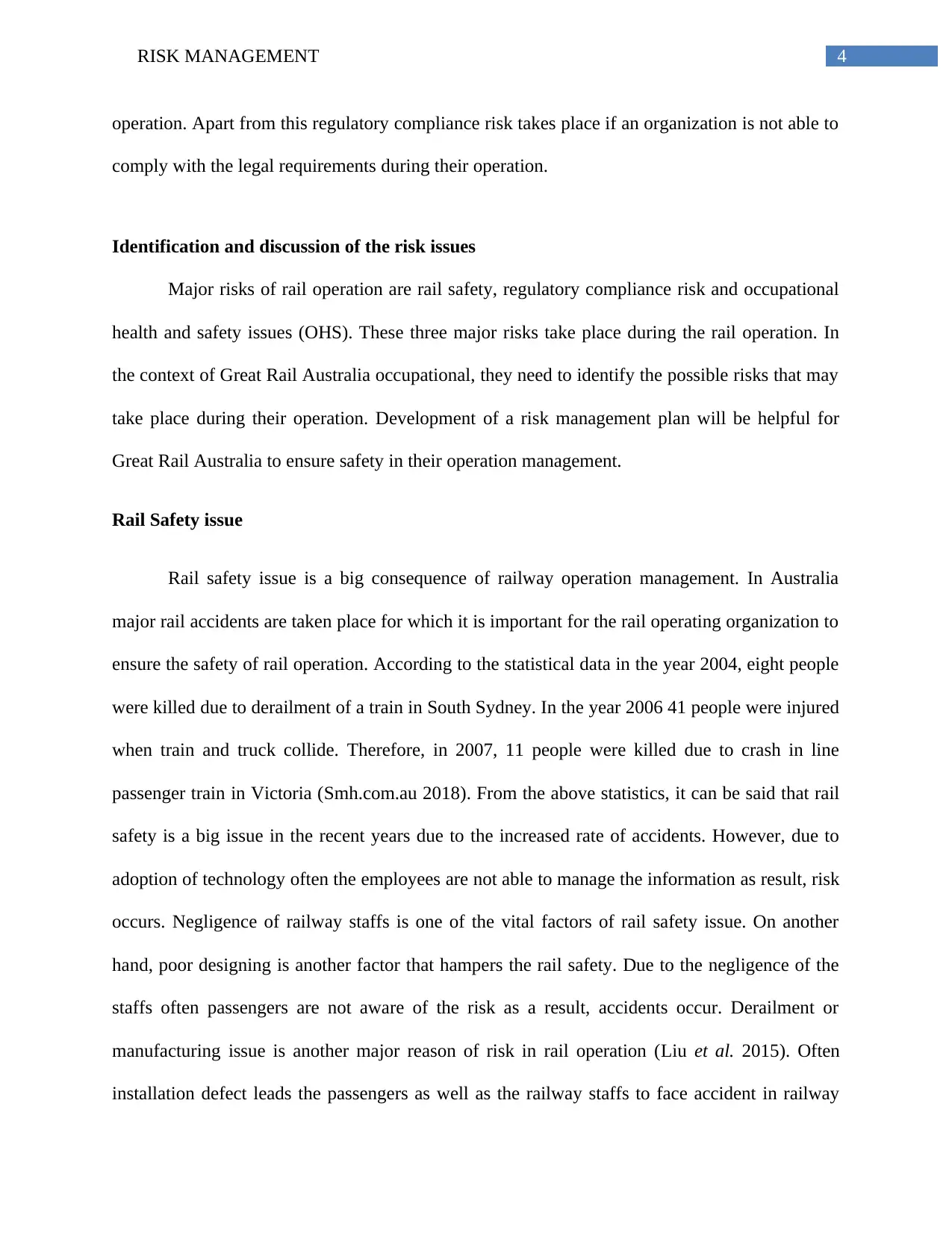
4RISK MANAGEMENT
operation. Apart from this regulatory compliance risk takes place if an organization is not able to
comply with the legal requirements during their operation.
Identification and discussion of the risk issues
Major risks of rail operation are rail safety, regulatory compliance risk and occupational
health and safety issues (OHS). These three major risks take place during the rail operation. In
the context of Great Rail Australia occupational, they need to identify the possible risks that may
take place during their operation. Development of a risk management plan will be helpful for
Great Rail Australia to ensure safety in their operation management.
Rail Safety issue
Rail safety issue is a big consequence of railway operation management. In Australia
major rail accidents are taken place for which it is important for the rail operating organization to
ensure the safety of rail operation. According to the statistical data in the year 2004, eight people
were killed due to derailment of a train in South Sydney. In the year 2006 41 people were injured
when train and truck collide. Therefore, in 2007, 11 people were killed due to crash in line
passenger train in Victoria (Smh.com.au 2018). From the above statistics, it can be said that rail
safety is a big issue in the recent years due to the increased rate of accidents. However, due to
adoption of technology often the employees are not able to manage the information as result, risk
occurs. Negligence of railway staffs is one of the vital factors of rail safety issue. On another
hand, poor designing is another factor that hampers the rail safety. Due to the negligence of the
staffs often passengers are not aware of the risk as a result, accidents occur. Derailment or
manufacturing issue is another major reason of risk in rail operation (Liu et al. 2015). Often
installation defect leads the passengers as well as the railway staffs to face accident in railway
operation. Apart from this regulatory compliance risk takes place if an organization is not able to
comply with the legal requirements during their operation.
Identification and discussion of the risk issues
Major risks of rail operation are rail safety, regulatory compliance risk and occupational
health and safety issues (OHS). These three major risks take place during the rail operation. In
the context of Great Rail Australia occupational, they need to identify the possible risks that may
take place during their operation. Development of a risk management plan will be helpful for
Great Rail Australia to ensure safety in their operation management.
Rail Safety issue
Rail safety issue is a big consequence of railway operation management. In Australia
major rail accidents are taken place for which it is important for the rail operating organization to
ensure the safety of rail operation. According to the statistical data in the year 2004, eight people
were killed due to derailment of a train in South Sydney. In the year 2006 41 people were injured
when train and truck collide. Therefore, in 2007, 11 people were killed due to crash in line
passenger train in Victoria (Smh.com.au 2018). From the above statistics, it can be said that rail
safety is a big issue in the recent years due to the increased rate of accidents. However, due to
adoption of technology often the employees are not able to manage the information as result, risk
occurs. Negligence of railway staffs is one of the vital factors of rail safety issue. On another
hand, poor designing is another factor that hampers the rail safety. Due to the negligence of the
staffs often passengers are not aware of the risk as a result, accidents occur. Derailment or
manufacturing issue is another major reason of risk in rail operation (Liu et al. 2015). Often
installation defect leads the passengers as well as the railway staffs to face accident in railway
Paraphrase This Document
Need a fresh take? Get an instant paraphrase of this document with our AI Paraphraser
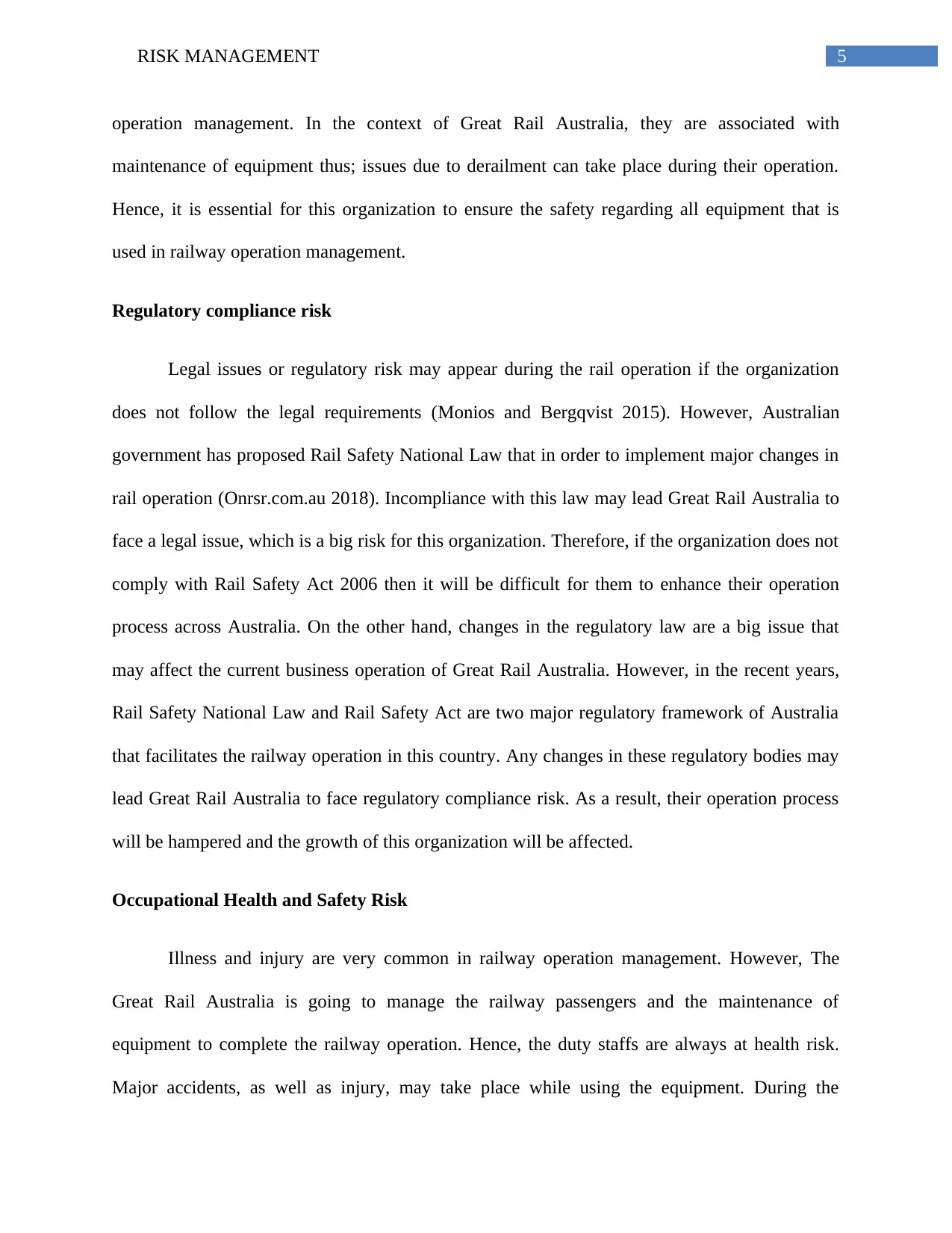
5RISK MANAGEMENT
operation management. In the context of Great Rail Australia, they are associated with
maintenance of equipment thus; issues due to derailment can take place during their operation.
Hence, it is essential for this organization to ensure the safety regarding all equipment that is
used in railway operation management.
Regulatory compliance risk
Legal issues or regulatory risk may appear during the rail operation if the organization
does not follow the legal requirements (Monios and Bergqvist 2015). However, Australian
government has proposed Rail Safety National Law that in order to implement major changes in
rail operation (Onrsr.com.au 2018). Incompliance with this law may lead Great Rail Australia to
face a legal issue, which is a big risk for this organization. Therefore, if the organization does not
comply with Rail Safety Act 2006 then it will be difficult for them to enhance their operation
process across Australia. On the other hand, changes in the regulatory law are a big issue that
may affect the current business operation of Great Rail Australia. However, in the recent years,
Rail Safety National Law and Rail Safety Act are two major regulatory framework of Australia
that facilitates the railway operation in this country. Any changes in these regulatory bodies may
lead Great Rail Australia to face regulatory compliance risk. As a result, their operation process
will be hampered and the growth of this organization will be affected.
Occupational Health and Safety Risk
Illness and injury are very common in railway operation management. However, The
Great Rail Australia is going to manage the railway passengers and the maintenance of
equipment to complete the railway operation. Hence, the duty staffs are always at health risk.
Major accidents, as well as injury, may take place while using the equipment. During the
operation management. In the context of Great Rail Australia, they are associated with
maintenance of equipment thus; issues due to derailment can take place during their operation.
Hence, it is essential for this organization to ensure the safety regarding all equipment that is
used in railway operation management.
Regulatory compliance risk
Legal issues or regulatory risk may appear during the rail operation if the organization
does not follow the legal requirements (Monios and Bergqvist 2015). However, Australian
government has proposed Rail Safety National Law that in order to implement major changes in
rail operation (Onrsr.com.au 2018). Incompliance with this law may lead Great Rail Australia to
face a legal issue, which is a big risk for this organization. Therefore, if the organization does not
comply with Rail Safety Act 2006 then it will be difficult for them to enhance their operation
process across Australia. On the other hand, changes in the regulatory law are a big issue that
may affect the current business operation of Great Rail Australia. However, in the recent years,
Rail Safety National Law and Rail Safety Act are two major regulatory framework of Australia
that facilitates the railway operation in this country. Any changes in these regulatory bodies may
lead Great Rail Australia to face regulatory compliance risk. As a result, their operation process
will be hampered and the growth of this organization will be affected.
Occupational Health and Safety Risk
Illness and injury are very common in railway operation management. However, The
Great Rail Australia is going to manage the railway passengers and the maintenance of
equipment to complete the railway operation. Hence, the duty staffs are always at health risk.
Major accidents, as well as injury, may take place while using the equipment. During the
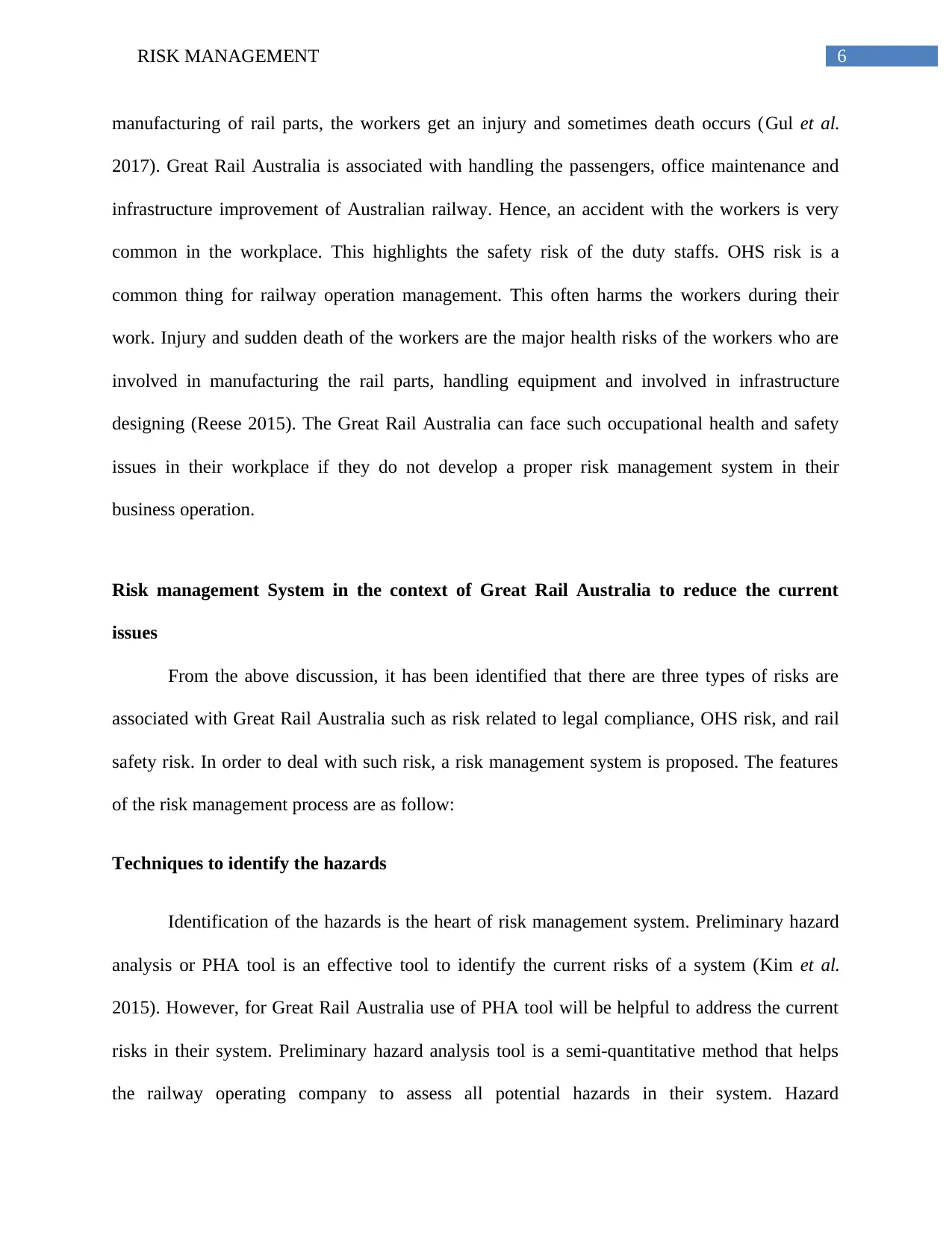
6RISK MANAGEMENT
manufacturing of rail parts, the workers get an injury and sometimes death occurs (Gul et al.
2017). Great Rail Australia is associated with handling the passengers, office maintenance and
infrastructure improvement of Australian railway. Hence, an accident with the workers is very
common in the workplace. This highlights the safety risk of the duty staffs. OHS risk is a
common thing for railway operation management. This often harms the workers during their
work. Injury and sudden death of the workers are the major health risks of the workers who are
involved in manufacturing the rail parts, handling equipment and involved in infrastructure
designing (Reese 2015). The Great Rail Australia can face such occupational health and safety
issues in their workplace if they do not develop a proper risk management system in their
business operation.
Risk management System in the context of Great Rail Australia to reduce the current
issues
From the above discussion, it has been identified that there are three types of risks are
associated with Great Rail Australia such as risk related to legal compliance, OHS risk, and rail
safety risk. In order to deal with such risk, a risk management system is proposed. The features
of the risk management process are as follow:
Techniques to identify the hazards
Identification of the hazards is the heart of risk management system. Preliminary hazard
analysis or PHA tool is an effective tool to identify the current risks of a system (Kim et al.
2015). However, for Great Rail Australia use of PHA tool will be helpful to address the current
risks in their system. Preliminary hazard analysis tool is a semi-quantitative method that helps
the railway operating company to assess all potential hazards in their system. Hazard
manufacturing of rail parts, the workers get an injury and sometimes death occurs (Gul et al.
2017). Great Rail Australia is associated with handling the passengers, office maintenance and
infrastructure improvement of Australian railway. Hence, an accident with the workers is very
common in the workplace. This highlights the safety risk of the duty staffs. OHS risk is a
common thing for railway operation management. This often harms the workers during their
work. Injury and sudden death of the workers are the major health risks of the workers who are
involved in manufacturing the rail parts, handling equipment and involved in infrastructure
designing (Reese 2015). The Great Rail Australia can face such occupational health and safety
issues in their workplace if they do not develop a proper risk management system in their
business operation.
Risk management System in the context of Great Rail Australia to reduce the current
issues
From the above discussion, it has been identified that there are three types of risks are
associated with Great Rail Australia such as risk related to legal compliance, OHS risk, and rail
safety risk. In order to deal with such risk, a risk management system is proposed. The features
of the risk management process are as follow:
Techniques to identify the hazards
Identification of the hazards is the heart of risk management system. Preliminary hazard
analysis or PHA tool is an effective tool to identify the current risks of a system (Kim et al.
2015). However, for Great Rail Australia use of PHA tool will be helpful to address the current
risks in their system. Preliminary hazard analysis tool is a semi-quantitative method that helps
the railway operating company to assess all potential hazards in their system. Hazard
⊘ This is a preview!⊘
Do you want full access?
Subscribe today to unlock all pages.

Trusted by 1+ million students worldwide
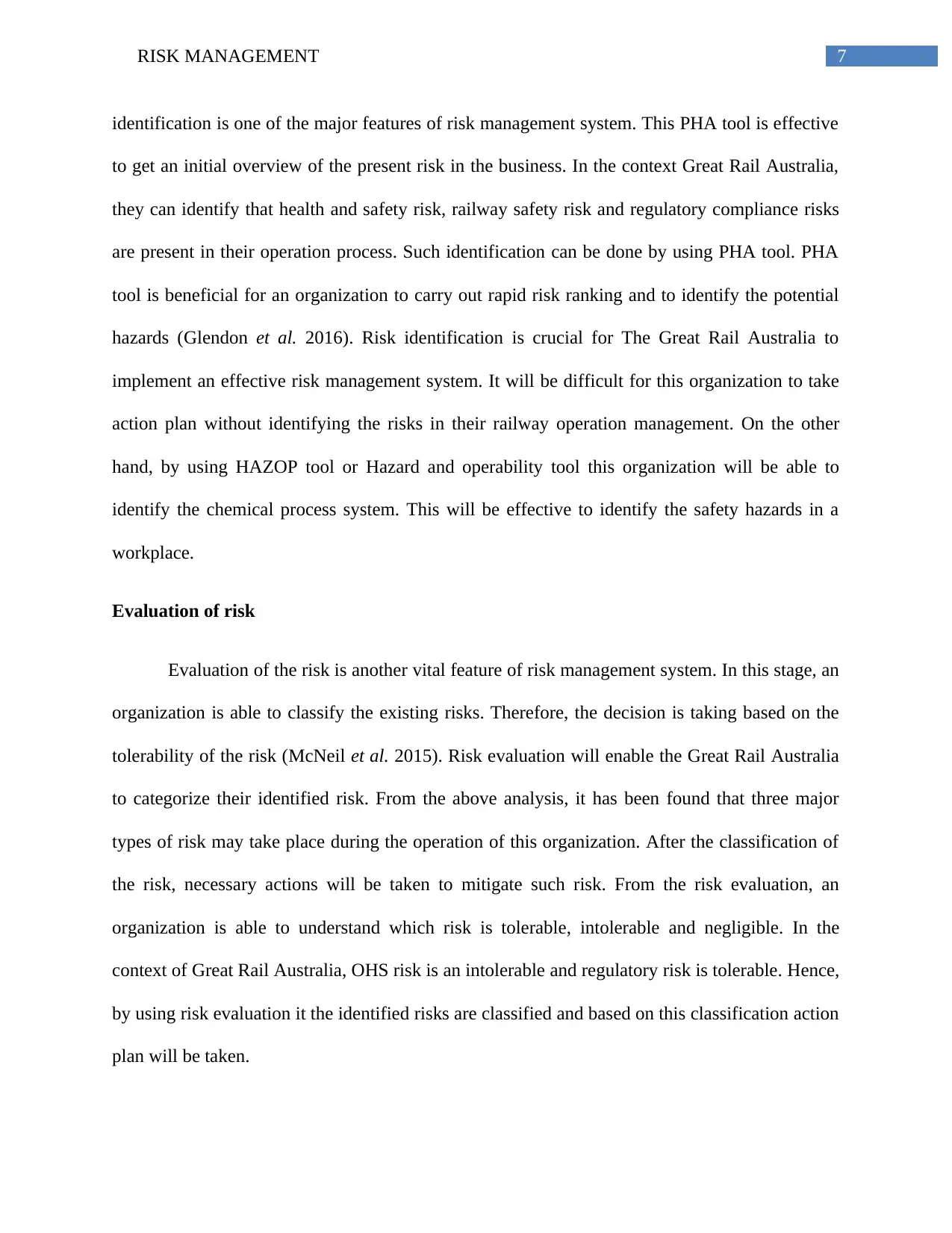
7RISK MANAGEMENT
identification is one of the major features of risk management system. This PHA tool is effective
to get an initial overview of the present risk in the business. In the context Great Rail Australia,
they can identify that health and safety risk, railway safety risk and regulatory compliance risks
are present in their operation process. Such identification can be done by using PHA tool. PHA
tool is beneficial for an organization to carry out rapid risk ranking and to identify the potential
hazards (Glendon et al. 2016). Risk identification is crucial for The Great Rail Australia to
implement an effective risk management system. It will be difficult for this organization to take
action plan without identifying the risks in their railway operation management. On the other
hand, by using HAZOP tool or Hazard and operability tool this organization will be able to
identify the chemical process system. This will be effective to identify the safety hazards in a
workplace.
Evaluation of risk
Evaluation of the risk is another vital feature of risk management system. In this stage, an
organization is able to classify the existing risks. Therefore, the decision is taking based on the
tolerability of the risk (McNeil et al. 2015). Risk evaluation will enable the Great Rail Australia
to categorize their identified risk. From the above analysis, it has been found that three major
types of risk may take place during the operation of this organization. After the classification of
the risk, necessary actions will be taken to mitigate such risk. From the risk evaluation, an
organization is able to understand which risk is tolerable, intolerable and negligible. In the
context of Great Rail Australia, OHS risk is an intolerable and regulatory risk is tolerable. Hence,
by using risk evaluation it the identified risks are classified and based on this classification action
plan will be taken.
identification is one of the major features of risk management system. This PHA tool is effective
to get an initial overview of the present risk in the business. In the context Great Rail Australia,
they can identify that health and safety risk, railway safety risk and regulatory compliance risks
are present in their operation process. Such identification can be done by using PHA tool. PHA
tool is beneficial for an organization to carry out rapid risk ranking and to identify the potential
hazards (Glendon et al. 2016). Risk identification is crucial for The Great Rail Australia to
implement an effective risk management system. It will be difficult for this organization to take
action plan without identifying the risks in their railway operation management. On the other
hand, by using HAZOP tool or Hazard and operability tool this organization will be able to
identify the chemical process system. This will be effective to identify the safety hazards in a
workplace.
Evaluation of risk
Evaluation of the risk is another vital feature of risk management system. In this stage, an
organization is able to classify the existing risks. Therefore, the decision is taking based on the
tolerability of the risk (McNeil et al. 2015). Risk evaluation will enable the Great Rail Australia
to categorize their identified risk. From the above analysis, it has been found that three major
types of risk may take place during the operation of this organization. After the classification of
the risk, necessary actions will be taken to mitigate such risk. From the risk evaluation, an
organization is able to understand which risk is tolerable, intolerable and negligible. In the
context of Great Rail Australia, OHS risk is an intolerable and regulatory risk is tolerable. Hence,
by using risk evaluation it the identified risks are classified and based on this classification action
plan will be taken.
Paraphrase This Document
Need a fresh take? Get an instant paraphrase of this document with our AI Paraphraser
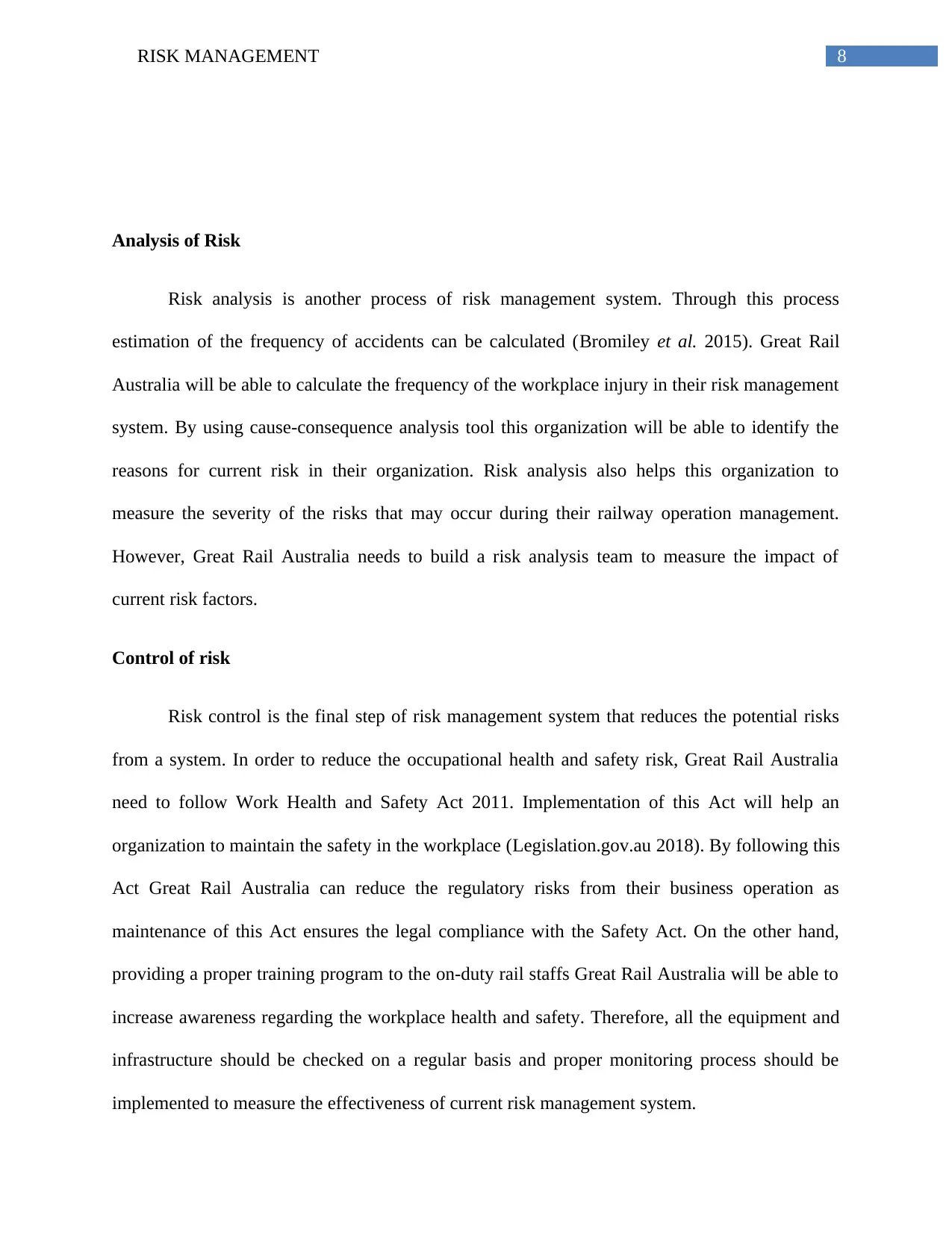
8RISK MANAGEMENT
Analysis of Risk
Risk analysis is another process of risk management system. Through this process
estimation of the frequency of accidents can be calculated (Bromiley et al. 2015). Great Rail
Australia will be able to calculate the frequency of the workplace injury in their risk management
system. By using cause-consequence analysis tool this organization will be able to identify the
reasons for current risk in their organization. Risk analysis also helps this organization to
measure the severity of the risks that may occur during their railway operation management.
However, Great Rail Australia needs to build a risk analysis team to measure the impact of
current risk factors.
Control of risk
Risk control is the final step of risk management system that reduces the potential risks
from a system. In order to reduce the occupational health and safety risk, Great Rail Australia
need to follow Work Health and Safety Act 2011. Implementation of this Act will help an
organization to maintain the safety in the workplace (Legislation.gov.au 2018). By following this
Act Great Rail Australia can reduce the regulatory risks from their business operation as
maintenance of this Act ensures the legal compliance with the Safety Act. On the other hand,
providing a proper training program to the on-duty rail staffs Great Rail Australia will be able to
increase awareness regarding the workplace health and safety. Therefore, all the equipment and
infrastructure should be checked on a regular basis and proper monitoring process should be
implemented to measure the effectiveness of current risk management system.
Analysis of Risk
Risk analysis is another process of risk management system. Through this process
estimation of the frequency of accidents can be calculated (Bromiley et al. 2015). Great Rail
Australia will be able to calculate the frequency of the workplace injury in their risk management
system. By using cause-consequence analysis tool this organization will be able to identify the
reasons for current risk in their organization. Risk analysis also helps this organization to
measure the severity of the risks that may occur during their railway operation management.
However, Great Rail Australia needs to build a risk analysis team to measure the impact of
current risk factors.
Control of risk
Risk control is the final step of risk management system that reduces the potential risks
from a system. In order to reduce the occupational health and safety risk, Great Rail Australia
need to follow Work Health and Safety Act 2011. Implementation of this Act will help an
organization to maintain the safety in the workplace (Legislation.gov.au 2018). By following this
Act Great Rail Australia can reduce the regulatory risks from their business operation as
maintenance of this Act ensures the legal compliance with the Safety Act. On the other hand,
providing a proper training program to the on-duty rail staffs Great Rail Australia will be able to
increase awareness regarding the workplace health and safety. Therefore, all the equipment and
infrastructure should be checked on a regular basis and proper monitoring process should be
implemented to measure the effectiveness of current risk management system.
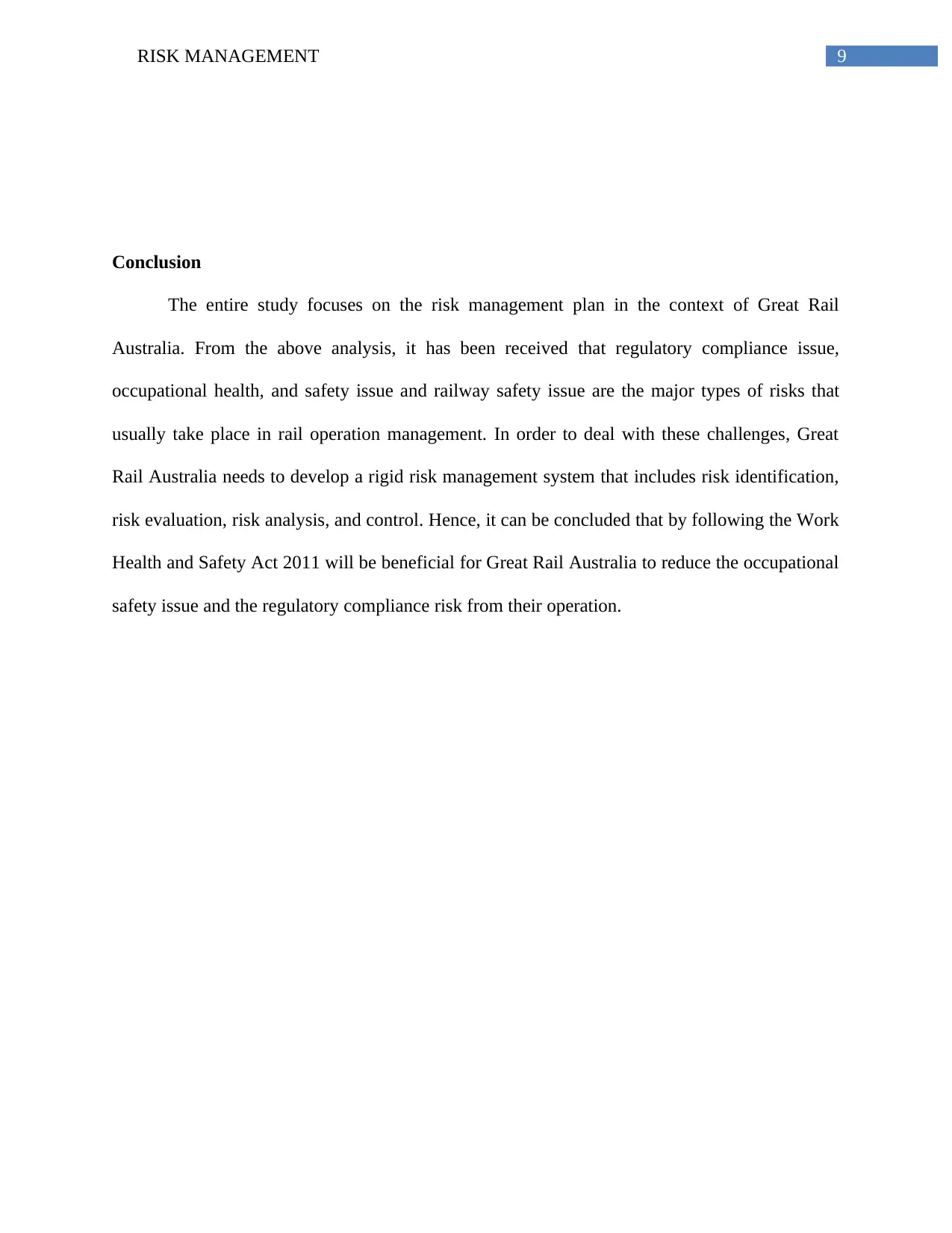
9RISK MANAGEMENT
Conclusion
The entire study focuses on the risk management plan in the context of Great Rail
Australia. From the above analysis, it has been received that regulatory compliance issue,
occupational health, and safety issue and railway safety issue are the major types of risks that
usually take place in rail operation management. In order to deal with these challenges, Great
Rail Australia needs to develop a rigid risk management system that includes risk identification,
risk evaluation, risk analysis, and control. Hence, it can be concluded that by following the Work
Health and Safety Act 2011 will be beneficial for Great Rail Australia to reduce the occupational
safety issue and the regulatory compliance risk from their operation.
Conclusion
The entire study focuses on the risk management plan in the context of Great Rail
Australia. From the above analysis, it has been received that regulatory compliance issue,
occupational health, and safety issue and railway safety issue are the major types of risks that
usually take place in rail operation management. In order to deal with these challenges, Great
Rail Australia needs to develop a rigid risk management system that includes risk identification,
risk evaluation, risk analysis, and control. Hence, it can be concluded that by following the Work
Health and Safety Act 2011 will be beneficial for Great Rail Australia to reduce the occupational
safety issue and the regulatory compliance risk from their operation.
⊘ This is a preview!⊘
Do you want full access?
Subscribe today to unlock all pages.

Trusted by 1+ million students worldwide
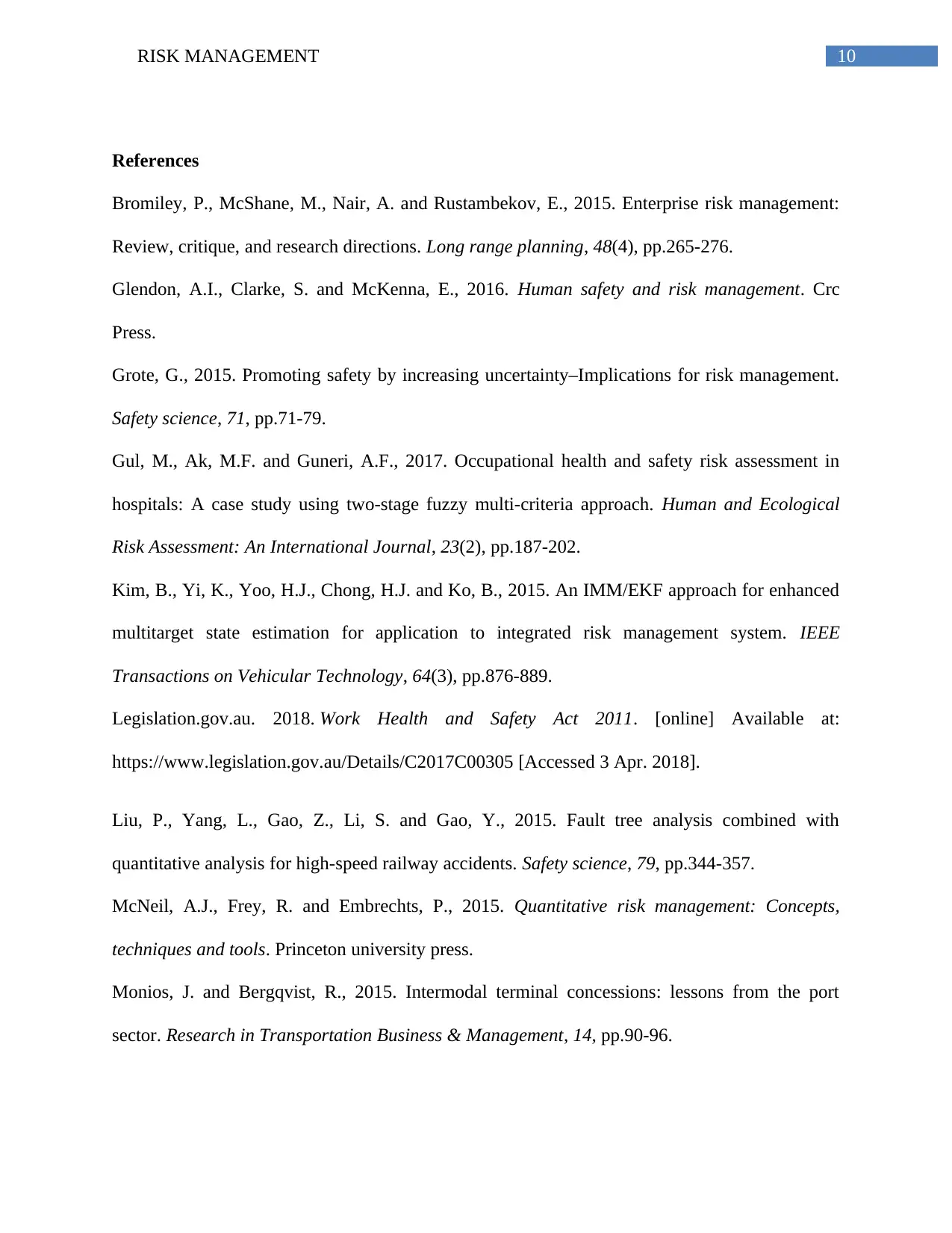
10RISK MANAGEMENT
References
Bromiley, P., McShane, M., Nair, A. and Rustambekov, E., 2015. Enterprise risk management:
Review, critique, and research directions. Long range planning, 48(4), pp.265-276.
Glendon, A.I., Clarke, S. and McKenna, E., 2016. Human safety and risk management. Crc
Press.
Grote, G., 2015. Promoting safety by increasing uncertainty–Implications for risk management.
Safety science, 71, pp.71-79.
Gul, M., Ak, M.F. and Guneri, A.F., 2017. Occupational health and safety risk assessment in
hospitals: A case study using two-stage fuzzy multi-criteria approach. Human and Ecological
Risk Assessment: An International Journal, 23(2), pp.187-202.
Kim, B., Yi, K., Yoo, H.J., Chong, H.J. and Ko, B., 2015. An IMM/EKF approach for enhanced
multitarget state estimation for application to integrated risk management system. IEEE
Transactions on Vehicular Technology, 64(3), pp.876-889.
Legislation.gov.au. 2018. Work Health and Safety Act 2011. [online] Available at:
https://www.legislation.gov.au/Details/C2017C00305 [Accessed 3 Apr. 2018].
Liu, P., Yang, L., Gao, Z., Li, S. and Gao, Y., 2015. Fault tree analysis combined with
quantitative analysis for high-speed railway accidents. Safety science, 79, pp.344-357.
McNeil, A.J., Frey, R. and Embrechts, P., 2015. Quantitative risk management: Concepts,
techniques and tools. Princeton university press.
Monios, J. and Bergqvist, R., 2015. Intermodal terminal concessions: lessons from the port
sector. Research in Transportation Business & Management, 14, pp.90-96.
References
Bromiley, P., McShane, M., Nair, A. and Rustambekov, E., 2015. Enterprise risk management:
Review, critique, and research directions. Long range planning, 48(4), pp.265-276.
Glendon, A.I., Clarke, S. and McKenna, E., 2016. Human safety and risk management. Crc
Press.
Grote, G., 2015. Promoting safety by increasing uncertainty–Implications for risk management.
Safety science, 71, pp.71-79.
Gul, M., Ak, M.F. and Guneri, A.F., 2017. Occupational health and safety risk assessment in
hospitals: A case study using two-stage fuzzy multi-criteria approach. Human and Ecological
Risk Assessment: An International Journal, 23(2), pp.187-202.
Kim, B., Yi, K., Yoo, H.J., Chong, H.J. and Ko, B., 2015. An IMM/EKF approach for enhanced
multitarget state estimation for application to integrated risk management system. IEEE
Transactions on Vehicular Technology, 64(3), pp.876-889.
Legislation.gov.au. 2018. Work Health and Safety Act 2011. [online] Available at:
https://www.legislation.gov.au/Details/C2017C00305 [Accessed 3 Apr. 2018].
Liu, P., Yang, L., Gao, Z., Li, S. and Gao, Y., 2015. Fault tree analysis combined with
quantitative analysis for high-speed railway accidents. Safety science, 79, pp.344-357.
McNeil, A.J., Frey, R. and Embrechts, P., 2015. Quantitative risk management: Concepts,
techniques and tools. Princeton university press.
Monios, J. and Bergqvist, R., 2015. Intermodal terminal concessions: lessons from the port
sector. Research in Transportation Business & Management, 14, pp.90-96.
Paraphrase This Document
Need a fresh take? Get an instant paraphrase of this document with our AI Paraphraser
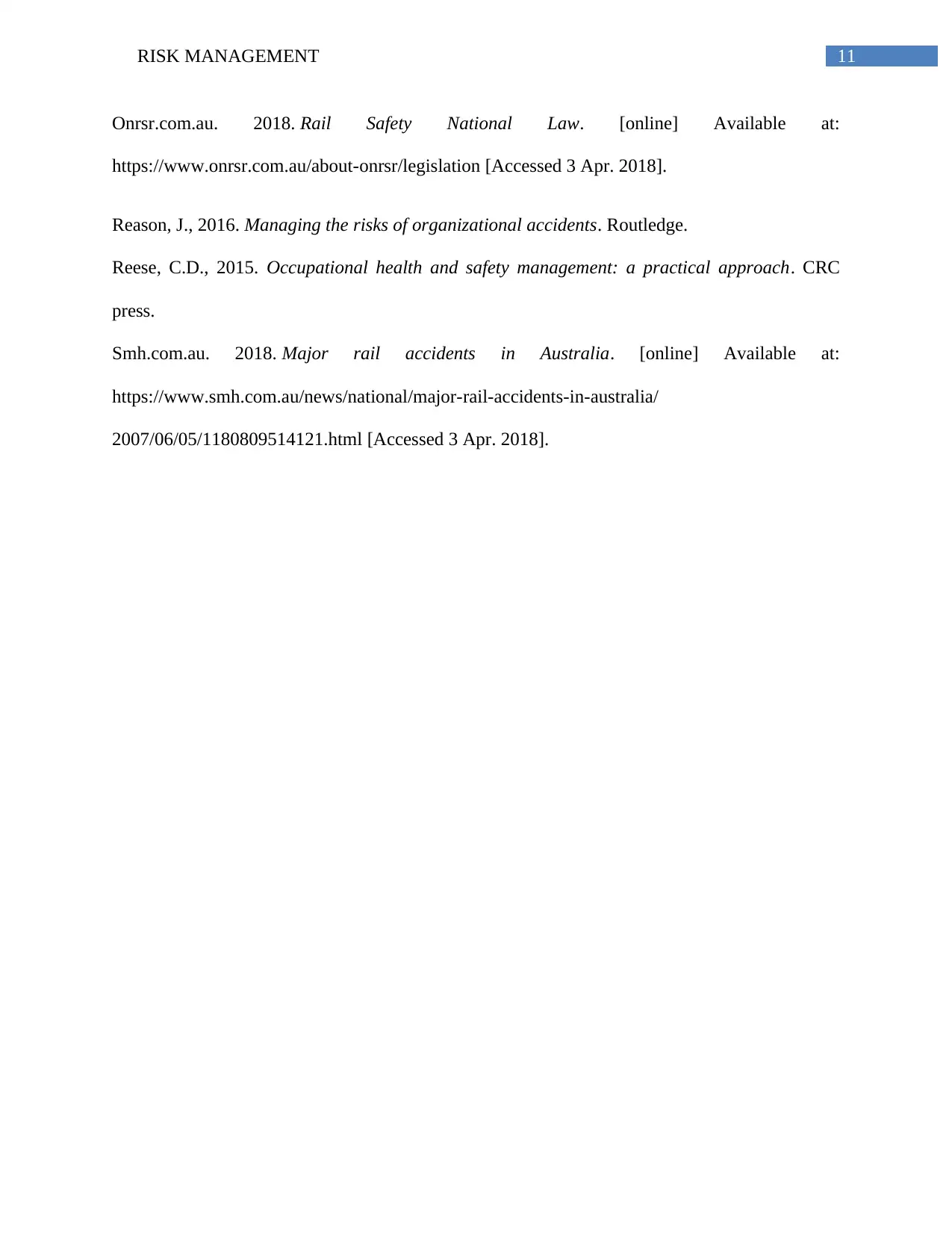
11RISK MANAGEMENT
Onrsr.com.au. 2018. Rail Safety National Law. [online] Available at:
https://www.onrsr.com.au/about-onrsr/legislation [Accessed 3 Apr. 2018].
Reason, J., 2016. Managing the risks of organizational accidents. Routledge.
Reese, C.D., 2015. Occupational health and safety management: a practical approach. CRC
press.
Smh.com.au. 2018. Major rail accidents in Australia. [online] Available at:
https://www.smh.com.au/news/national/major-rail-accidents-in-australia/
2007/06/05/1180809514121.html [Accessed 3 Apr. 2018].
Onrsr.com.au. 2018. Rail Safety National Law. [online] Available at:
https://www.onrsr.com.au/about-onrsr/legislation [Accessed 3 Apr. 2018].
Reason, J., 2016. Managing the risks of organizational accidents. Routledge.
Reese, C.D., 2015. Occupational health and safety management: a practical approach. CRC
press.
Smh.com.au. 2018. Major rail accidents in Australia. [online] Available at:
https://www.smh.com.au/news/national/major-rail-accidents-in-australia/
2007/06/05/1180809514121.html [Accessed 3 Apr. 2018].
1 out of 11
Related Documents
Your All-in-One AI-Powered Toolkit for Academic Success.
+13062052269
info@desklib.com
Available 24*7 on WhatsApp / Email
![[object Object]](/_next/static/media/star-bottom.7253800d.svg)
Unlock your academic potential
Copyright © 2020–2025 A2Z Services. All Rights Reserved. Developed and managed by ZUCOL.





